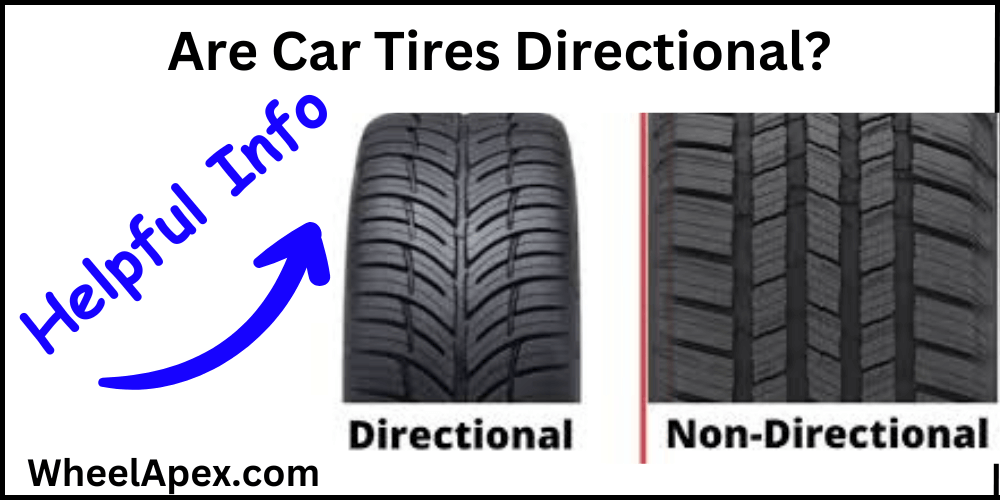Car tires are a crucial component of vehicle safety and performance. One aspect that often perplexes drivers is whether tires are directional. Directional tires have specific tread patterns designed to rotate in one direction. Aiming to optimize performance in certain conditions. Are car tires directional? In this article, we’ll explore the intricacies of directional tires. Their advantages, and considerations for drivers.
Contents
Are Car Tires Directional?
Are car tires directional? Directional tires are identifiable by their distinctive V-shaped or arrow-like tread patterns. These patterns are crafted to enhance traction and handling. And water dispersion in wet conditions. The key feature of directional tires is that they are designed to rotate in a specific direction. Indicated by an arrow or “rotation” markings on the sidewall.
Advantages of Directional Tires
Enhanced Wet Traction: The primary advantage of directional tires lies. In their ability to channel water away from the tire’s contact patch. The V-shaped tread grooves disperse water. They are reducing the risk of hydroplaning and improving wet traction. This makes directional tires an excellent choice for drivers in regions with frequent rain or wet road conditions. These car tires can protect you from lightning.
Improved Handling and Stability: The directional tread pattern is designed. To optimize grip and stability. Particularly during high-speed driving or sudden maneuvers. This makes directional tires popular for performance-oriented vehicles where precise handling is paramount.
Reduced Rolling Resistance: Some directional tires incorporate features. That reduces rolling resistance, enhancing fuel efficiency. By directing airflow more and minimizing drag. These tires contribute to better mileage, making them a friendly option.
Considerations for Drivers
Proper Installation and Rotation: Directional tires must be mounted to ensure optimal performance. The rotation direction is indicated on the sidewall. Should match the intended rotation direction of the vehicle. Proper tire rotation is crucial to promote even wear and extend tire life.
Limitations in Snow and Ice: Directional tires excel in wet conditions. There may be better choices for snowy or icy roads. The V-shaped tread pattern can trap snow, reducing traction in winter conditions. In such cases, drivers may opt for all-season or winter tires with a different tread design.
Uneven Wear Patterns: Improper tire maintenance, such as neglecting regular rotations. It can lead to uneven wear patterns. This can affect the tire’s performance and lifespan. Drivers should adhere to the manufacturer’s recommendations for tire rotation intervals.
Do Car Tires Have A Direction?
Many modern car tires have a specific rotational direction indicated by arrows on the sidewall. Are car tires directional? This directional design enhances traction, water evacuation, and performance. Mounting them ensures optimal safety and efficiency. Always check the tire sidewall markings. Follow the manufacturer’s guidelines for proper installation.
Are All Car Tires Directional?
Not all car tires are directional. Directional tires have a specific tread pattern designed. For optimal performance in one direction. Non-directional tires can rotate in any direction. The choice depends on the vehicle’s design and the driver’s preferences. Considering factors like handling, traction, and tire rotation options.
Are Some Tires Non-Directional?
Some tires are non-directional. Unlike directional tires designed to rotate in a specific direction. For optimal performance, non-directional tires can be mounted in any direction. This versatility simplifies tire rotation and replacement. Providing flexibility without compromising safety or functionality.
Do Tires Have to Be Mounted in A Certain Direction?
Tires need to be mounted in a specific direction for optimal performance and safety. The sidewall of the tire usually has markings indicating the correct rotation. This ensures proper tread pattern alignment, traction, and handling. Incorrect mounting may compromise vehicle stability and tire longevity. Always follow manufacturer guidelines.
Conclusion
Directional tires offer a range of advantages. Are car tires directional? Particularly in wet conditions and high-performance driving scenarios. Drivers need to understand their specific needs and the conditions they must drive. Proper installation, routine maintenance, and consideration of seasonal requirements. These are crucial aspects of maximizing the benefits of directional tires. As with any tire choice, a well-informed decision is based on driving habits and environmental factors. Manufacturer guidelines are key to ensuring a safe and enjoyable driving experience.
Sources:
- By Tim Gordon Are directional tires better than non-directional tires? Posted 1 Year Ago.

